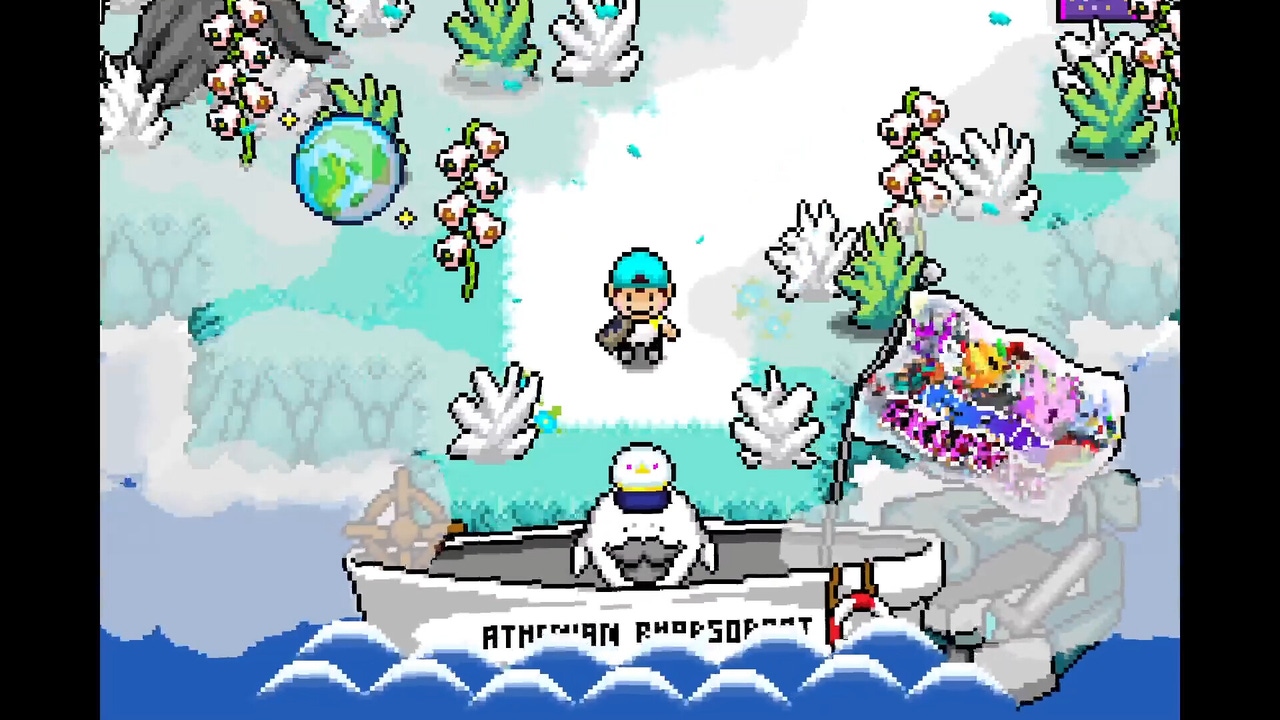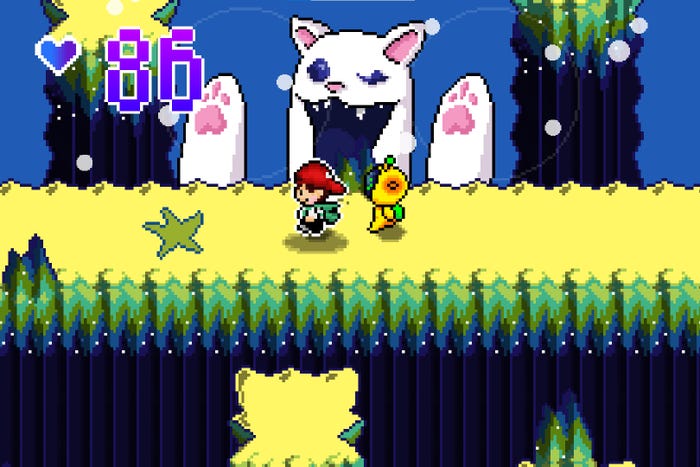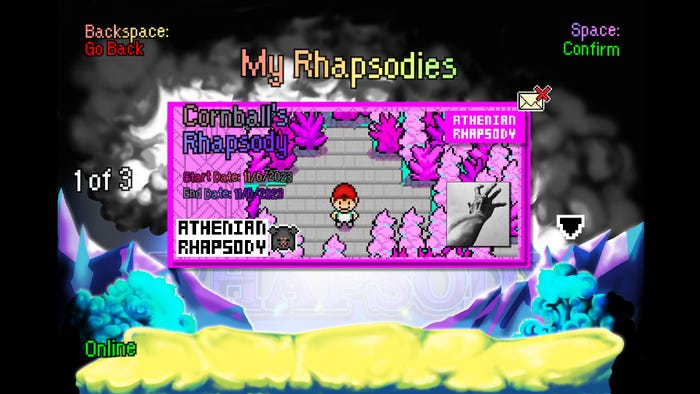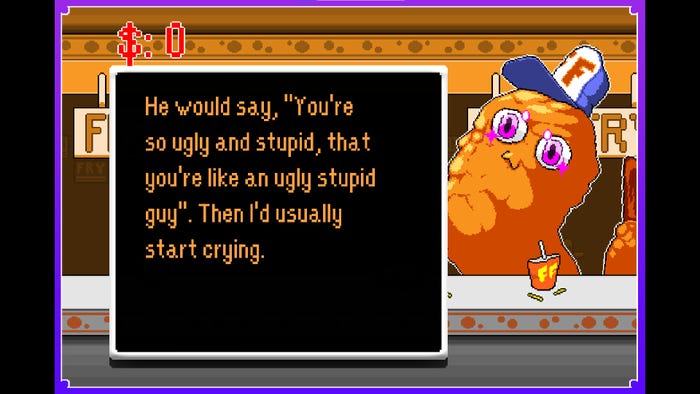Sharing laughs and swapping save files in Athenian Rhapsody
Creator Nico Papalia talks about what thoughts went into creating a game where no two playthroughs should be the same and how he turned player saves into collectibles.

Athenian Rhapsody takes players through a ridiculous RPG world filled with silly characters and even sillier minigames. The hijinks can get so out of hand that the playthroughs themselves can become a unique collectible that players can trade with one another.
Game Developer sat down with Nico Papalia, the game’s creator, to talk about how their budding experience in GameMaker would shape the game’s minigame combat and systems, what thoughts went into creating a game where no two playthroughs should be the same, and how to turn player saves into a collectible (with some inspiration from the popularity of the original Pokémon games).
Game Developer: Athenian Rhapsody is a playful, minigame-filled RPG romp through a ridiculous world. Can you tell us a bit about what inspired the creation of this game?
Nico Papalia: I started Athenian Rhapsody while learning GameMaker for fun during the pandemic. A great friend of mine used it to make games of his own, and I thought it could be a fun activity. I ended up falling in love with the feeling of creating the game, and it snowballed into what we have here!
I grew up on the GameBoy Advance and older consoles, and those games were immediately what came to mind in terms of what kind of game I wanted to make. I wanted to recreate that era of my life when my friends, cousins, and I would cluelessly navigate games like Pokémon Emerald (even down to giving Athenian Rhapsody the same resolution as the GBA). Most of us could barely read at that point, and the ones who could had no idea how to progress the story. So, we all kind of aimlessly played around the same part of the game, doing virtually nothing, but that experience was vital to the creation of Athenian Rhapsody—the wonder of not knowing what’s next or what else the game contains was enough to keep exploring, playing, and having fun.
The humor and overall vibes of the game are a pretty good reflection of how my friends and I interact. I had a ritual of waking up and just adding or writing whatever I thought was funny that morning and never really changing it; the whole thing was built intuitively. Whatever I was interested in at the time or any character I had a cool idea for, I would chase and create alongside the game’s composer, Arp, and we’d bring it to life. This did make it difficult to tie it all together at times, but I don’t think I can make games any other way.

Images via Top Hat Studios.
What thoughts went into its art style? How did you work to design a visual theme that would immediately draw the player into the silly mood of the game's world?
Before working on video games, I studied transformational anatomy and my main interest was drawing with graphite; when transitioning into pixel art for Athenian Rhapsody, my first visuals were absolutely terrible. The game looked like hot garbage! Honestly, it just took a long time of actually doing it, the occasional studies, and a lot of mental work on the sprites until the game’s art style came together consistently.
Later on, I did plan very specifically not to make each biome too RPG-cliche. In Athenian Rhapsody, you reach a mountain biome—in this biome, like several others in the game, I wanted to add a twist that separated it from being just a normal mountain. I tried to add a magic twist and make the rocks look like they contained galaxies with stars in them to give it more of an interesting look. Many of my biomes and scenes were inspired by Adventure Time and the way the land of Ooo is designed, too.
Your combat system is filled with many, many dodging minigames for players to enjoy, giving combat a lively and often surprisingly hilarious feel. What appealed to you about creating a combat system like this?
Papalia: To be completely honest, I originally wanted to create a game that worked like Pokémon Mystery Dungeon. The only problem was that I had absolutely no idea how to even begin creating that.
I thought, “Okay, let me take a step down and create a battle system similar to the mainline Pokémon games…” The only problem was that I had absolutely no idea how to begin creating that, either.
When beginning, my programming skills and knowledge of GameMaker were so poor that I would create all of my dialogue in Photoshop, export it as an image, and then import it into GameMaker as a graphic. Changing dialogue was a nightmare. What I did know how to do was how to make things move around, so I began to make what I imagined a Pokémon battle would look like. Instead of turn-based combat, I wanted to use real-time action and dodging to imagine what the enemy’s attacks would look like.
Eventually, as my skills and knowledge grew, I wanted to expand from that and more into a space inspired by games like WarioWare. I did this through the game’s many REACT minigames used to befriend the opponents—in the future in any games I make, I want to reach into this category even more!
Can you tell us about how you designed some of the minigames? Any particular favorites you're especially proud of, or that never fail to make a player chuckle?
Papalia: Usually when designing a character, I have a whole mental plan in mind. I really think about who they are, what they sound like, things they say, and eventually what situation they find themselves meeting the player in. One of my personal favorite battles is the one against McFishness, the bodybuilding squid. You meet him in his gym and undergo his ultimate training program before beginning his battle; during the battle, you need to mash the correct keys to lift up a dumbbell all the way to the top of a bicep, and once you do that, you have to complete a DDR-inspired rhythm minigame to pull off bodybuilding poses with your fresh new pump.
Another favorite of mine is Aerosol’s battle, where you clumsily paint your own picture using your movement controls (which always turns out looking pretty jacked up, as you could imagine). Some other favorites of mine would be Giga Franklin’s "Hoo! Ha!" thing he does while you complete his battle, Meesha's and Flipper's battles have also been fan favorites after appearing in the spin-off demo Athenian Rhapsody: Thunder Goober’s Personality Dungeon as well.
You mention that choice is an integral part of the game. Many games have made such claims, but on your store page, you go further, stating "Your story will unfold based on your decisions, to the degree of which cannot be replicated by any other player." Can you tell us a bit about how you are weaving so many decisions into the game's world and making them matter? How are you creating a game where player experiences can be this vastly different?
The idea of choose-your-own-adventure interested me specifically because I wanted to make an experience that was unique and special to each player. It seems like many RPGs produced now follow what Undertale brought to the scene in having multiple pathways, your decisions affecting your morality, and being treated differently based on the decisions you made through the story. I wanted to expand on this idea and turn it into a much more extreme version of the concept; many players who play new RPGs expect them to function exactly like Undertale, and I wanted to shake up that preconceived notion and introduce them with something that would catch them off guard.
In Athenian Rhapsody, I provided players with multiple different angles to attack each scenario individually. Players can do very little and complete the game, or they can do a whole lot. The story happens modularly—I often compare the game’s story to a tree with branches of varying sizes and thicknesses that weave in different directions and angles. There are definitely enough decisions, big and small, that I’m confident no two players would ever achieve the same exact playthrough (then receive the same Rhapsody). I also tried to put all of this completely in the player’s hands—the only RNG present is during the game’s Pokémon Mystery Dungeon-inspired personality quiz, where the selected questions are random.
Athenian Rhapsody features a Rhapsody system, an online social element that involves collectible and tradeable save states. Where did the idea for this system come from? What sparked the idea of being able to trade saves with other players?
Many of my ideas and concepts came from studying how Pokémon’s first generation was made and how its mechanics impacted its popularity. As a huge Pokémon fan, I knew the feeling players had when completing a playthrough with a Pokémon and having a special bond to the character you own; it serves as a token or relic of your adventure through a region that reminded you of all of the challenges and shenanigans that happened during that time. I wanted to somehow combine the feeling of having a special Pokémon of your own with which players build a relationship with and cherish but without the actual Pokémon, since I was making Athenian Rhapsody and definitely don’t have the rights to add Poliwhirl into the game.
I spent a long time thinking about how I would provide players with something special, too. I also had this "Rhapsody" idea, but it wasn't really fleshed out yet. I had no idea how to piece everything together and give players a reason to play my game more than once, and to reward them for doing so. I wanted to bring players together, give them a reason to talk about their experiences, to remember Athenian Rhapsody, and for the experience, frankly, not to end. Just because they finished the game, I didn’t want their experience to be completely over. Visions of people showing up to events and parties with their Gameboys to collect special event Pokémon flashed around in my head, and I wanted to create something similar.
I remember a lot of days staring into space at the gym, trying to craft up what eventually became the Rhapsody system—a player’s save file upon finishing the game turns into a highly customizable postcard that contains the entire adventure! It’ll even have a photo you took from the actual game on it (thanks, Earthbound)!
I remember pitching the idea to my publishers at Top Hat Studios—walls of text, diagrams, slideshows; I was all in. Luckily, they were VERY interested in the idea and wanted to work to help me achieve this vision and eventually develop the system’s networking functions which allow players to trade and collect Rhapsodies cross-platform.
A Bohemian chic Rhapsody

Images via Top Hat Studios.
How do you turn save states and player progress into collectibles? How do you make these saves appealing to collect and trade?
When a player finishes a game, they’re taken to a menu where they can customize the appearance of the Rhapsody they are about to create; they can add badges, postmarks, choose a paper color, pattern, and more to go alongside their uniquely branded postcard. Inside that postcard, a huge amount of crucial information in regards to what you actually did during your playthrough is present—which followers you used the most, the least, if you had irritable bowel syndrome and how many times you farted, if you tried to cure that IBS and failed (or succeeded), how many projectiles you were hit by, your favorite food, and more!
The game also contains four different pathways players can take through the story, each giving them a different type of Rhapsody which are organized by colors: Fuchsia, Grey, Yellow, and Magenta. Players can combine any two, or THREE Rhapsodies of different types to create stacked Rhapsodies, which combine and compare all of the data present within the stack.
It could be a very romantic first date to stack Rhapsodies together with someone else… Actually, that may be too serious for a first date—some people wait all the way until marriage to stack Rhapsodies with a significant other. It’s pretty serious since you can’t un-stack them.
What thoughts went into developing the game in such a way that it turned game saves into something akin to trading cards? And how do these collectible saves affect the design of the game?
The funny thing is that I actually did not design it with this in mind; I just created bits and pieces that I thought were funny at the time, and eventually, I had hours and hours of gameplay and content that I needed to make sense of. This was almost paralyzing when it came time to tie together the game’s endings and actually create the Rhapsody system. It took a lot of deep thought, thinking, planning, and asking myself questions about what I wanted players to experience, how I wanted them to feel, and what I wanted Athenian Rhapsody to achieve in the long term.
Eventually, an idea started coming together on how an experience that felt like Pokémon’s first generation of creature collecting and trading’s social features could work—trading Rhapsodies, collecting accolades, and most importantly, keeping your playthrough experiences for as long as you wish to cherish them.
I tried very hard to visualize and explain this concept to my team and publishers Top Hat Studios; luckily, they were incredibly interested in the concept and wanted to help me achieve that vision. As I mentioned previously, I’ve learned to use GameMaker studios alongside the development of this game and the functionality of creating something that could connect every platform together to trade and collect Rhapsodies online was completely out of my reach at that time. Luckily, Top Hat Studios developed all of the inner mechanisms, which create user profiles, allow players to trade cross-platform, stack, and keep their Rhapsodies in the cloud. It took quite a bit of time to create these systems and ensure that they all worked together, but in the end, it came together exactly as we had planned initially.
Once this concept was in place, I started fleshing out other things to make the Rhapsodies unique and adding more obscure gameplay elements to push their rarity. One great example of a gameplay mechanic specifically designed to be shown off on the Rhapsodies are the "Munchkins." Players can download a "Munchkin" in the options menu if they hold a strong connection from their system to Elysium, which should take about 5 or 6 minutes. Rhapsodies in their final form are highly customizable and feature a plethora of badges to choose from based on segments of the story that players have experienced.

Images via Top Hat Studios.
To make these Rhapsodies truly stand out, you would need to give the player many, many, many things to do. What challenges come out of designing an RPG with an incredibly large amount of things players can do?
For me, the challenge wasn't giving them enough things to do—it was stopping! I love creating funny little things that happen. Actually, I wish I could literally just do that… the cutscenes I create and story scenarios are sometimes purely for my own amusement. I’m not ashamed to say that when I replay the game I actually laugh at the dialogue that I forgot existed, which is pretty weird but also makes sense.
The challenges that came alongside this concept often came from having 16 party members. Wanting to create individual experiences for each of them within the story meant a lot of writing dialogue, individual cutscenes, and nitty-gritty work for each and every one of them.
Some other challenges came from balancing the game and making sure the information was presented in a way that players could properly investigate and discover some of the more obscure pathways that will affect the Rhapsody as well.
About the Author
You May Also Like









